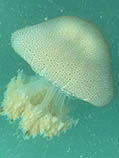Rhopilema hispidum (Vanhöffen, 1888)
Sand jellyfish
Classification / Names Κοινά ονόματα | Συνώνυμα | CoL | ITIS | WoRMS
Scyphozoa | Rhizostomeae | Rhizostomatidae
Environment: milieu / climate zone / εύρος βάθους / distribution range Οικολογία
. Tropical; 45°N - 20°S, 44°E - 146°E (Αναφ. 121705)
Distribution Χώρες | Περιοχές FAO | Οικοσυστήματα | Παρουσίες | Εισαγωγές
Indo-West Pacific: from Gulf of Aden north to Japan and east to Pacific..
Length at first maturity / Μέγεθος / Weight / Age
Γεννητική Ωρίμανση: Lm ? range ? - ? cm Max length : 70.0 cm WD αρσενικό/απροσδιόριστο; (Αναφ. 121705)
Short description Μορφολογία
Life cycle and mating behavior Γεννητική Ωρίμανση | Αναπαραγωγή | Γεννοβολία | Eggs | Γονιμότητα | Larvae
Main reference
Αναφορές | Συντονιστής | Συνεργάτες
Kramp, P.L. 1961 Synopsis of the medusae of the world. J Mar Biol Ass UK 40:1-469. (Αναφ. 2992)
IUCN Red List Status
(Αναφ. 130435: Version 2025-1)
CITES status (Αναφ. 108899)
CMS (Αναφ. 116361)
Threat to humans
Human uses
αλιεία: Εμπορικό(ά)
| FishSource |
Εργαλεία
Περισσότερες πληροφορίες
Σύσταση δίαιτας
Κατανάλωση τροφής
Θηρευτές
Διαδικτυακές πηγές
BHL | BOLD Systems | CISTI | DiscoverLife | FAO(Publication : search) | Fishipedia | GenBank (genome, nucleotide) | GloBI | Gomexsi | Google Books | Google Scholar | Google | PubMed | Δέντρο Ζωής | Wikipedia (Go, αναζήτηση) | Zoological Record



